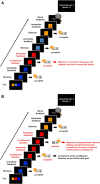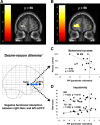When desire collides with reason: functional interactions between anteroventral prefrontal cortex and nucleus accumbens underlie the human ability to resist impulsive desires
- PMID: 20107076
- PMCID: PMC6633806
- DOI: 10.1523/JNEUROSCI.4690-09.2010
When desire collides with reason: functional interactions between anteroventral prefrontal cortex and nucleus accumbens underlie the human ability to resist impulsive desires
Abstract
Human decisions are guided by "desire" or "reason," which control actions oriented toward either proximal or long-term goals. Here we used functional magnetic resonance imaging to assess how the human brain mediates the balance between proximal reward desiring and long-term goals, when actions promoting a superordinate goal preclude exploitation of an immediately available reward option. Consistent with the view that the reward system interacts with prefrontal circuits during action control, we found that behavior favoring the long-term goal, but counteracting immediate reward desiring, relied on a negative functional interaction of anteroventral prefrontal cortex (avPFC) with nucleus accumbens (Nacc) and ventral tegmental area. The degree of functional interaction between avPFC and Nacc further predicted behavioral success during pursuit of the distal goal, when confronted with a proximal reward option, and scaled with interindividual differences in trait impulsivity. These findings reveal how the human brain accomplishes voluntary action control guided by "reason," suggesting that inhibitory avPFC influences Nacc activity during actions requiring a restraint of immediate "desires."
Figures



Comment in
-
Uncovering the neural basis of resisting immediate gratification while pursuing long-term goals.J Neurosci. 2010 May 5;30(18):6178-9. doi: 10.1523/JNEUROSCI.1341-10.2010. J Neurosci. 2010. PMID: 20445042 Free PMC article. No abstract available.
References
-
- Brett M, Anton J, Valabregue R, Poline J. Region of interest analysis using an SPM toolbox. Neuroimage. 2002;16(Suppl 1):1141.
-
- Cloninger CR, Svrakic DM, Pryzbeck TR. A psychobiological model of temperament and character. Arch Gen Psychiatry. 1993;50:975–990. - PubMed
-
- Dalley JW, Mar AC, Economidou D, Robbins TW. Neurobehavioral mechanisms of impulsivity: fronto-striatal systems and functional neurochemistry. Pharmacol Biochem Behav. 2008;90:250–260. - PubMed
MeSH terms
LinkOut - more resources
Full Text Sources
